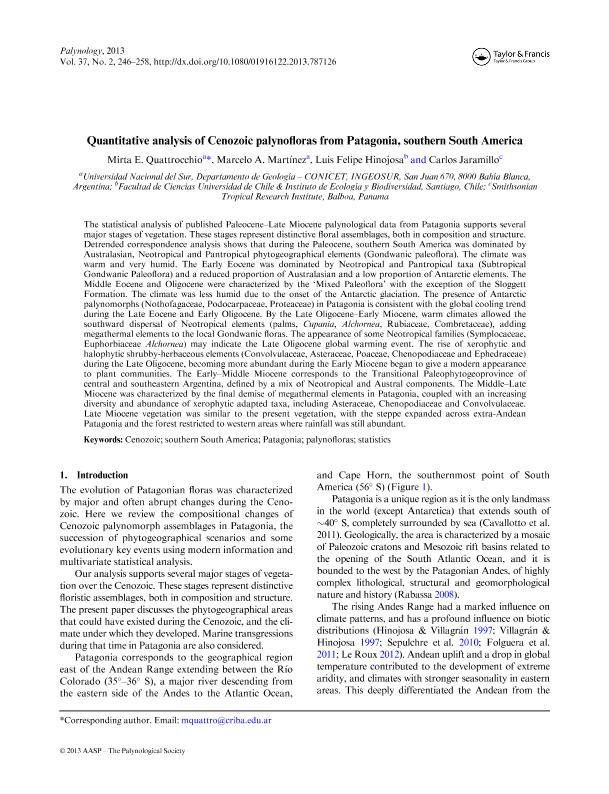Artículo
Quantitative analysis of Cenozoic palynofloras from Patagonia (southern South America).
Fecha de publicación:
01/2013
Editorial:
Taylor & Francis
Revista:
Palynology
ISSN:
0191-6122
Idioma:
Inglés
Tipo de recurso:
Artículo publicado
Clasificación temática:
Resumen
The statistical analysis of published Paleocene-Late Miocene palynological data from Patagonia supports several major stages of vegetation. These stages represent distinctive floral assemblages, both in composition and structure. Detrended correspondence analysis shows that during the Paleocene, southern South America was dominated by Australasian, Neotropical and Pantropical phytogeographical elements (Gondwanic paleoflora). The climate was warm and very humid. The Early Eocene was dominated by Neotropical and Pantropical taxa (Subtropical Gondwanic Paleoflora) and a reduced proportion of Australasian and a low proportion of Antarctic elements. The Middle Eocene and Oligocene were characterized by the -Mixed Paleoflora-with the exception of the Sloggett Formation. The climate was less humid due to the onset of the Antarctic glaciation. The presence of Antarctic palynomorphs (Nothofagaceae, Podocarpaceae, Proteaceae) in Patagonia is consistent with the global cooling trend during the Late Eocene and Early Oligocene. By the Late Oligocene-Early Miocene, warm climates allowed the southward dispersal of Neotropical elements (palms, Cupania, Alchornea, Rubiaceae, Combretaceae), adding megathermal elements to the local Gondwanic floras. The appearance of some Neotropical families (Symplocaceae, Euphorbiaceae Alchornea) may indicate the Late Oligocene global warming event. The rise of xerophytic and halophytic shrubby-herbaceous elements (Convolvulaceae, Asteraceae, Poaceae, Chenopodiaceae and Ephedraceae) during the Late Oligocene, becoming more abundant during the Early Miocene began to give a modern appearance to plant communities. The Early-Middle Miocene corresponds to the Transitional Paleophytogeoprovince of central and southeastern Argentina, defined by a mix of Neotropical and Austral components. The Middle-Late Miocene was characterized by the final demise of megathermal elements in Patagonia, coupled with an increasing diversity and abundance of xerophytic adapted taxa, including Asteraceae, Chenopodiaceae and Convolvulaceae. Late Miocene vegetation was similar to the present vegetation, with the steppe expanded across extra-Andean Patagonia and the forest restricted to western areas where rainfall was still abundant.
Palabras clave:
Cenozoic
,
Southern South America
,
Patagonia
,
Palynofloras
,
Statistics
Archivos asociados
Licencia
Identificadores
Colecciones
Articulos(INGEOSUR)
Articulos de INST.GEOLOGICO DEL SUR
Articulos de INST.GEOLOGICO DEL SUR
Articulos(SEDE CENTRAL)
Articulos de SEDE CENTRAL
Articulos de SEDE CENTRAL
Citación
Quattrocchio, Mirta Elena; Martinez, Marcelo Adrian; Hinojosa, Luis Felipe; Jaramillo, Carlos; Quantitative analysis of Cenozoic palynofloras from Patagonia (southern South America).; Taylor & Francis; Palynology; 37; 2; 1-2013; 246-258
Compartir
Altmétricas




